Samsung Galaxy S 4 Review - Part 1
by Brian Klug on April 24, 2013 12:01 AM ESTDisplay
We wrote about how we suspected that SGS4 would go to a 5-inch 1080p SAMOLED display just after CES. Turns out that was spot on, as the SGS4 includes a 5-inch 1080p Full HD SAMOLED panel, the latest in Samsung's AMOLED roadmap. Samsung's naming stays true, and there's no Plus tacked on at the end, so we get another non-RGB stripe subpixel geometry with SGS4. The last few Samsung AMOLED variants we've seen have had different subpixel grids, and the one on the SGS4 is possibly the most interesting to date. There's still a bias toward more green subpixels than blue or red, this isn't an RGB stripe at all, but instead of the previous RG,BG layout we see this offset pattern with green on one line, then blue and red on another line. Interestingly enough the blue subpixel appears to be a square, and red and green appear to be circles, with the difference in area possibly offsetting the luminous efficiency of each material. Whatever the reason (Samsung has never been official or forthcoming any of these subpixel patterns each time they've changed them) it's present on the SGS4.
At this size however I have to admit that I find the pursuit of the subpixel geometry more of an educational one than something which affects users. While I could occasionally see it on the SGS3, I definitely do not see it on SGS4. The subpixels are now small enough that whatever the pattern, it all looks like a homogenous light-emitting surface, which was the goal after all. I could bring up the visual acuity discussion again but just trust me that it's small enough to not be visible even with actually perfect (not legally perfect, which is different) vision.
So resolution is great and up to par with all the other LCD-bearing flagships this year, lack of RGB stripe notwithstanding. There's that remaining question about brightness, contrast, outdoor visibility, and of course calibration and the saturation issue that has persisted with AMOLED from generation to generation.
On the brightness front, the SGS4 includes dynamic contrast functions that cannot be disabled and change as a function of what is being displayed. There's an "auto adjust screen tone" checkbox under display but don't let that fool you, that doesn't disable dynamic contrast, just white point. Under screen mode are the mDNIe toggles we've seen on countless other previous Samsung Android phones with AMOLED panels, only here we notice something interesting. There have always been four toggles as long as this option has existed, only what's different is now, one of them is named "Professional photo." Reviews of other regional variants of the SGS4 have included the same button but marked "Adobe RGB." Oddly enough it seems that the North American versions at least have this renamed for some reason, but undoubtedly the function is the same. Many speculated that this is now a toggle for some full CMS (Color Management System) which "fixes" the inherent color space issues with AMOLED and oversaturation that occurs when looking at sRGB content on such devices. Unfortunately, I can confirm that my initial suspicions that this is just a continuation of the mDNIe (lite) settings from previous generation is in fact correct. I reverse engineered what I could of these settings from both kernel messages while changing the toggles, and looking at the kernel sources. Turns out that 'Professional photo' mode is actually the 'Natural' mode renamed from previous versions.
So the question was whether the color space or white point actually does change with this mode enabled. I ran the SGS4 through our display tests in each of the modes and think the full color space plot tells the story. The sanest of them all really ends up being the strangely-named 'Movie' mode. Professional photo gives the big gamut with a white point closer to 'Movie,' which is to say around 7000K, but it doesn't fundamentally change the still-present oversaturation or color management issue that exists in Android with these wide gamut displays. Most users admittedly don't care however and just see "bright" colors. Theres' an Auto mode as well which the device ships with that basically has a matrix of mDNIe settings for targeted applications (for example the Gallery, Browser, Video playback) and so forth get settings, which you can see in the kernel.
| CalMAN Display Comparison | ||||||||||||
| Metric | iPhone 5 | iPhone 4S | HTC One X | SGS3 | Samsung Galaxy Note 2 | Google Nexus 4 | HTC Droid DNA | HTC One | SGS4 | |||
| Grayscale 200nits Avg dE2000 | 3.564 | 6.162 | 6.609 | 4.578 | 5.867 | 7.686 | 6.738 | 5.391 | 7.511 | |||
| CCT Avg (K) | 6925 | 7171 | 5944 | 6809 | 7109 | 8506 | 8108 | 8118 | 7020 | |||
| Saturation Sweep Avg dE2000 | 3.591 | 8.787 | 5.066 | 5.460 | 7.986 | 8.517 | 5.856 | 3.365 | 7.823 | |||
| GMB ColorChecker Avg dE2000 | 4.747 | 6.328 | 6.963 | 7.322 | 8.185 | 7.531 | 6.687 | 4.656 | 7.440 | |||
In the "Movie" mode things are better controlled than the Note 2 on the GMB color checker card test, which is the most important one for me. White point is also no longer the crazy 8000K that we saw before, 7000K is commendable for Samsung at this point. Keep in mind that maximum brightness changes in each mode as well as we effectively clamp things, I measured a maximum of 319 nits in Dynamic mode, 311 nits in Movie mode, and 255 nits in Standard, for example.
Running the display at maximum brightness for too long will also get you into an overheating or thermal protection mode as well, which we've seen on countless other AMOLED variants. Most of the time I suspect users will run on Auto brightness however which keeps brightness down to a much lower level to save battery and prevent that from becoming a problem.
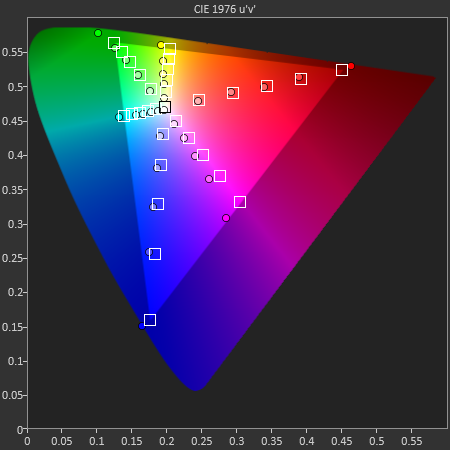
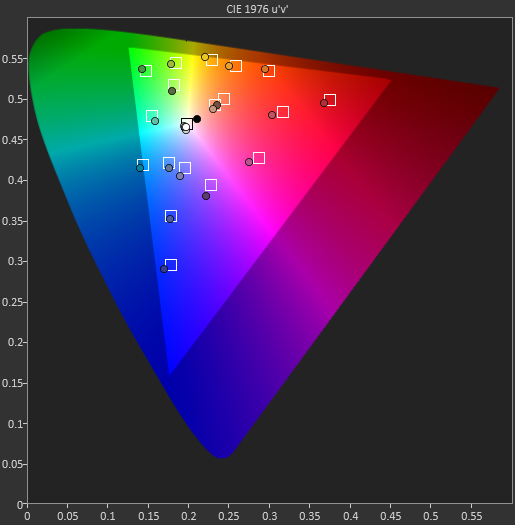
Because "Movie" was the closest to sRGB of all the modes, I selected it for the actual results that I'll present in the table. Admittedly this mode does tighten things up a bit, but it still isn't perfect and I'd still like to see Samsung do something to reign this in at some point.


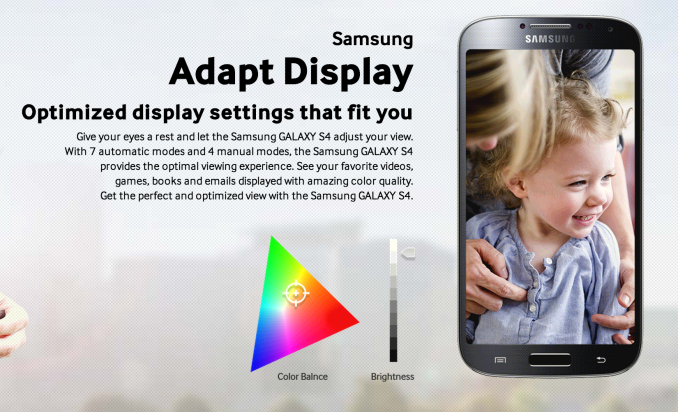




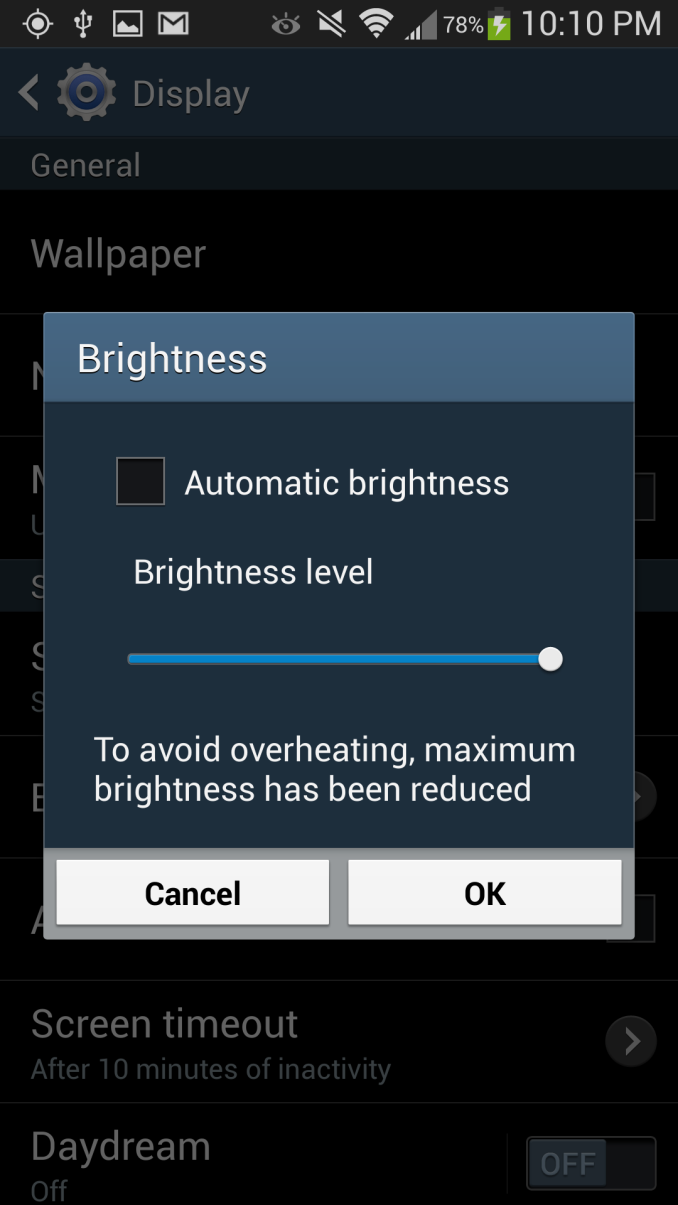
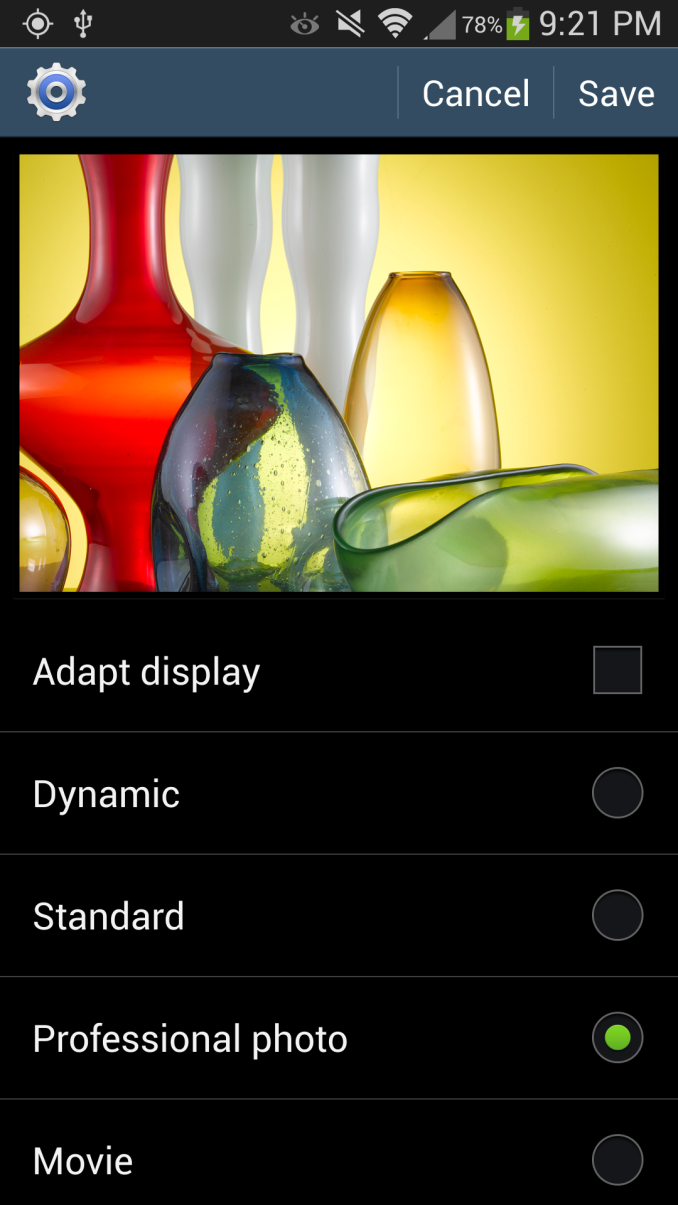
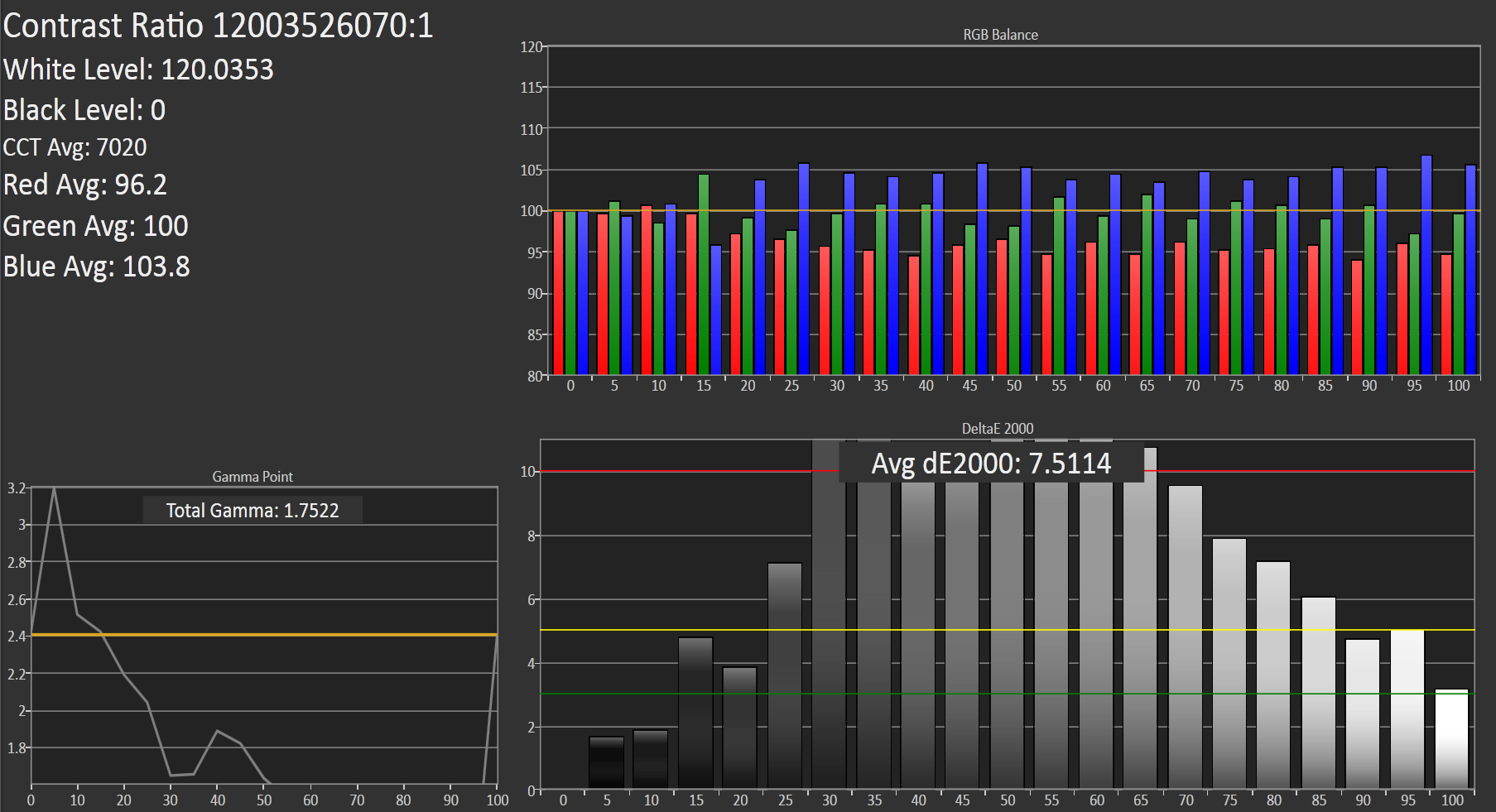








335 Comments
View All Comments
krumme - Wednesday, April 24, 2013 - link
Comparing at 200 nits, is fine, but at that brightness you actually get a more contrasty picture of Oled because of the darkness. For all practical usage - depending on your eyes - you can turn brightness relatively more down on the Oled.You might note that the color accuracy of the S4 is far better than the One. Thats not to mention the contrast. Ofcourse it lacks the brightness. But the presentation here is one sided.
If you find yourself at bars at night or shooting food at the restaurant go for the One camera. But before you do, you might want to compare the pictures plenty available on the net on fx. gsmarena or phonearena
UpSpin - Wednesday, April 24, 2013 - link
If the surrounding is bright, you need a bright display, which OLED struggles at, even with a better contrast, which gets more and more negligible the brighter your surrounding is. At night however you really see the difference between the true black OLED and greyish LCD.I don't know how to properly interpret the color charts, so I judge by the impression of the author which favors the HTC One display (see the HTC One review and this review 'Admittedly this mode does tighten things up a bit, but it still isn't perfect and I'd still like to see Samsung do something to reign this in at some point. ') and the numbers in the article:
HTC One vs. SGS4
Grayscale 200nits Avg dE2000: 5.391 vs. 7.511
CCT Avg (K): 8118 vs. 7020
Saturation Sweep Avg dE2000: 3.365 vs. 7.823
GMB ColorChecker Avg dE2000: 4.656 vs. 7.440
The color charts seem to look better for the SGS4, the 'Total gamma' and greyscale charts however disastrous.
krumme - Wednesday, April 24, 2013 - link
For practical usage i agree the brightness for most people can be an issue in sunlight. We just have to remember there is much more at play here than just brightness.But at the same way using a phone in bright surroundings favor the saturation of Oled.
I never understand the standard setting on the S2 or S3. It gave stupid colors imho (and the sharpness wasnt there either imho compared to LCD competition). But if you chose fx. natural on the S3 i think you are pretty much where the colors is okey for everything personal. Its the grey scale that suffers - the shaddow details is very bad imho. Apparently thats still an issue on the S4.
But the basic problem about reviewing the display this way, is that we get zero numbers for the all important dynamics of the picture. And its just so obvious for the eye that oled got something here.
nerd1 - Wednesday, April 24, 2013 - link
What matters is the perceived CONTRAST, not the brightness itself.Practically AMOLED has better contrast overall, which helps sunlight reading a bit although bit dimmer.
sigmatau - Thursday, April 25, 2013 - link
I feel you are just guessing based on what you see on paper. My Samsung AMOLED plus screen is useless in the sun with full brightness. Most reviewers said that the HTC's screen kills the S4's screen. I am thinking of buying an HTC One and trying it out for a day or two before deciding. I really do like the blacks on OLED screens.krumme - Thursday, April 25, 2013 - link
Nonsense. Plenty sites gives the edge to Samsung. But i guess most just turn the autopilot on. Something happened since your amoled screen. Sunlight legibility is a personal matter, because reflection also plays a big role.sigmatau - Thursday, April 25, 2013 - link
Bull shit. My OLED screen is the best with Nokia's superior filter and still is terrible in the sunlight. I have to find shade just to use the phone. And remember, mine is a plus OLED screen, these on the S3 and S4 are not, which makes them worse.UpSpin - Thursday, April 25, 2013 - link
The glass reflects a lot of the sunlight.The display must be brighter than the reflections to remain readable. That's independent of contrast in the first place. So either reduce the reflections (AR coating, Nokia polarisation) or increase the brightness. The contrast isn't important in the first place here. OLEDs have a lower brightness than LCD, thus, and just as every review talking about outdoor use agrees with, LCD is much better readable outdoors.If you have a very dark display with an impressive contrast you won't see anything in sunlight, because the reflections are much brighter than the content on your display.
Special outdoor display also don't just have RGB, but RGBW, just to make it even brighter for outdoor use.
krumme - Thursday, April 25, 2013 - link
Go here to see an measurement of sunlight contrast ratio:http://www.gsmarena.com/samsung_galaxy_s4-review-9...
S4 is quite good, and if i recall about the same order as One.
ssj3gohan - Wednesday, April 24, 2013 - link
Wait a sec... you have an LTE/HSPA synthesizer, right? Why don't you try out battery life with that, so you're guaranteed to have equal signal strength, bandwidth and latency throughout the tests instead of having to rely on different vendors, signal quality and concurrency.